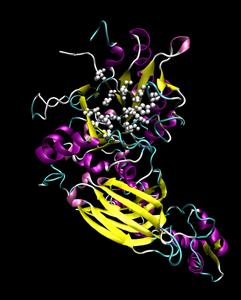Phosphoinositide phospholipase C
| Phosphoinositide phospholipase C | ||
|---|---|---|

|
||
| Belt model of the PLC δ-1 according to PDB 1DJX . The active center is highlighted as a CPK sphere model. | ||
| Cofactor | Calcium | |
| Identifier | ||
| Gene name (s) | PLC | |
| Enzyme classification | ||
| EC, category | 3.1.4.11 , phospholipase | |
| Response type | hydrolysis | |
| Substrate | Phosphatidylinositol-4,5-bisphosphate + H 2 O | |
| Products | Inositol 1,4,5-trisphosphate + diacylglycerol | |
| Occurrence | ||
| Parent taxon | Eukaryotes | |
Phosphoinositide phospholipase C (also phospholipase C , PLC for short ) are called enzymes that hydrolyze phosphatidylinositol-4,5-bisphosphate (PIP 2 ) to inositol trisphosphate (IP 3 ) and diacylglycerol (DAG). This reaction step is responsible for the transmission of signals from the outside of the cell to the inside. Vertebrates have six types of PLCs (β, γ, δ, ε, ζ, η), while lower eukaryotes have fewer PLC types. The types differ in terms of their regulation and localization in the organism, and there are several isoforms for each type .
function
In contrast to phospholipases A 1 , A 2 and D, phospholipase C splits phospholipids between glycerol and the phosphate group after activation (see figure). The secondary signals inositol trisphosphate (IP 3 ) and diacylglycerol (DAG), which are important for cellular signal transduction, are formed from phosphatidylinositol-4,5-bisphosphate .
Phospholipases of the type Cβ are activated by G proteins (G q ). It is stimulated by a signal at the G-protein-coupled receptor (7-TM receptor), which activates the alpha subunit of G q . Possible signals can be hormones , neurohormones and sensory signals such as fragrances or light.
Type Cγ phospholipases, on the other hand, are phosphorylated on a specific tyrosine residue by receptor tyrosine kinases . PLCγ also contains SH2 and SH3 domains to which proteins bind for a further signal response.
See also
Individual evidence
- ^ Gerhard Krauss: Biochemistry of Signal Transduction and Regulation . Wiley-VCH; 2nd, change Edition 2001; ISBN 978-3527303779 ; P. 211ff.
